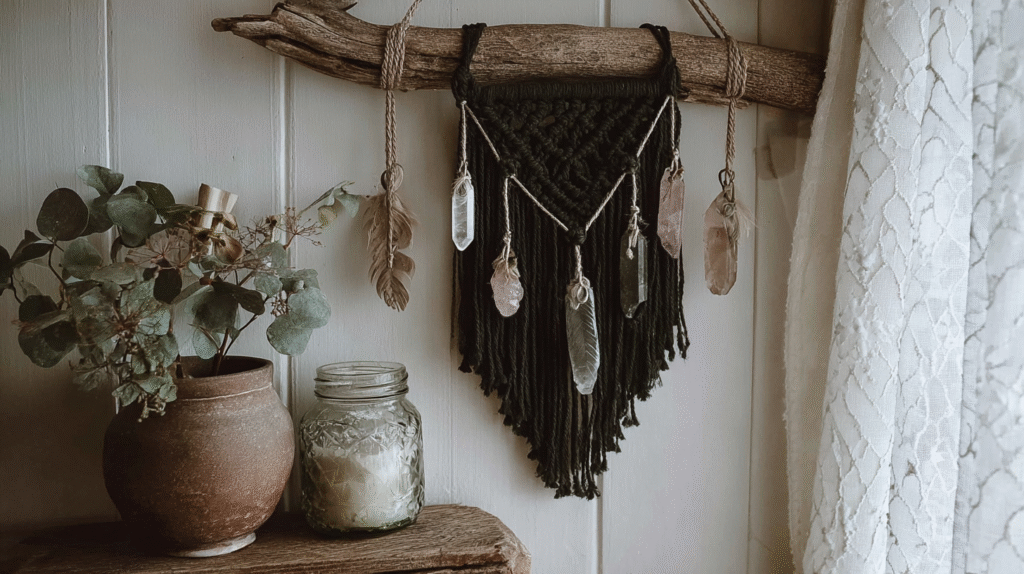This post may contain affiliate links, including those from Amazon Associates. If you make a purchase through these links, I may earn a commission at no additional cost to you. Learn more about our affiliate policy.
There is something special and magical about dried flowers, right? They carry memory in their petals, texture in their stems, and twilight tones in their fading color.
When artfully displayed, they become more than preserved blooms: they become elegant pieces of nature woven into our walls. Daily reminders of what we come from, our true origins.
If you’ve gathered or dried flowers and want to turn them into wall art that feels both enchanted and intimate, here are eight beautiful ways to display them.
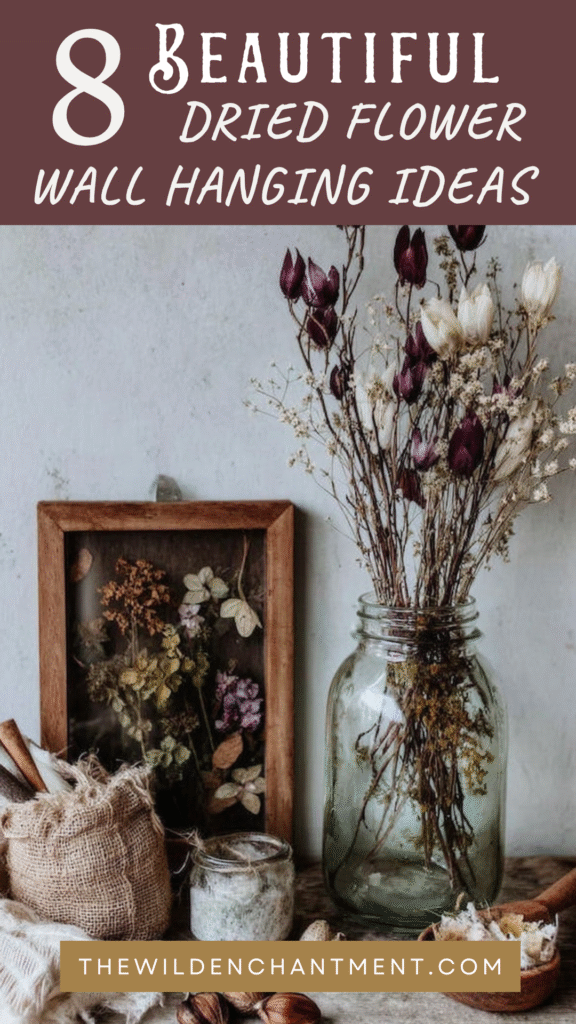
How to Prepare Your Flowers First
Before we hang or frame, some housekeeping:
- Drying methods: air-drying (hang upside down in a dry dark place), pressing (between heavy books or in a press), or using silica gel.
- Color and fragility: darker or more colorful blooms may fade in sunlight; gentle handling is key since petals become fragile.
- Mounting basics: acid-free paper or fabric backings, frames with glass or glazing, shadow boxes for depth. Also consider sealants or fixatives if desired.
Knowing this helps every method below look its best and last.
Shadow Boxes for Keepsakes
Shadow boxes are perfect when you have a bouquet you hold dear like wedding flowers, anniversary blooms, or perhaps a wild-flower mix collected on a special walk. The depth allows blooms to keep their shape.
How to do it: choose a shadow box frame, a background (linen, craft paper, or wood), arrange stems, secure with floral pins or glue, and close gently. You might layer small blooms on top of greenery or seed pods for texture.
Why it feels magical: the dimensionality, like peering through a window into a moment in time.
For a step-by-step demonstration, try this tutorial:
Pressed Flower Frames / Botanical Prints
Flattened blooms capture delicate details like vein lines, soft petal edges, subtle color gradations. Framed under glass, they feel herbarium-like and timeless.
Steps: press flowers for at least one to two weeks until completely dry, arrange on acid-free paper or cards, maybe sketch or paint behind them, then seal under glass. Use tape, tiny corner mounts, or archival glue.
If you’d like a full guide, Sky Lark House shares helpful tips for creating pressed and dried floral arrangements in their tutorial: How to Make Your Own Dried Flower Arrangement.
Moss and Dried Flower Mixed Wall Art in Deep Frames

This creates almost a tapestry of natural matter: moss, dried grasses, seedpods, and blooms in a deep frame. The moss gives texture and a lush base, which makes the blooms stand out.
One lovely tutorial to inspire: DIY Anthropologie-Inspired Dried Flower Wall Art by A Life Unfolding shows how to pair moss and dried flowers inside an old frame to make an autumnal piece full of depth and life. (See the tutorial here).
Tips: start with moss adhered well (hot glue or strong craft adhesive), arrange stems in layers, use floral pins for heavier parts, trim stray glue threads, and hang somewhere that doesn’t get damp.
Hanging Swags and Bundles
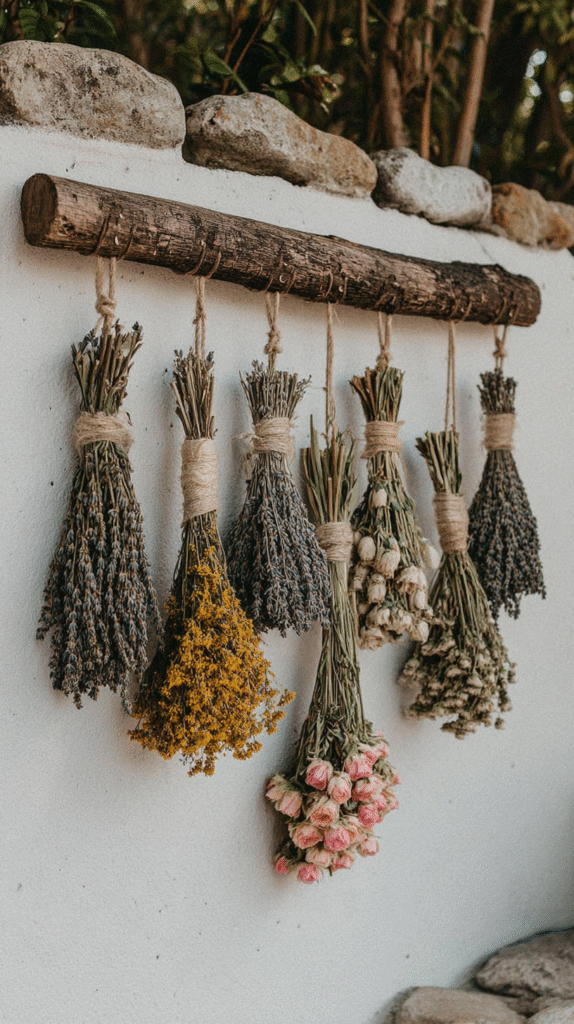
This is a more relaxed, botanical-wild approach: tie small bundles or swags of dried flowers and hang them upside down or with their heads pointed down or out. Sometimes around sticks, rods, or mounted on simple nails.
Choose flowers with strong stems such as lavender, eucalyptus, bunny tails, and grasses so they hold their shape. The asymmetry of letting stems drape can feel more intimate than rigid shapes.
Hoop or Embroidery-Style Displays
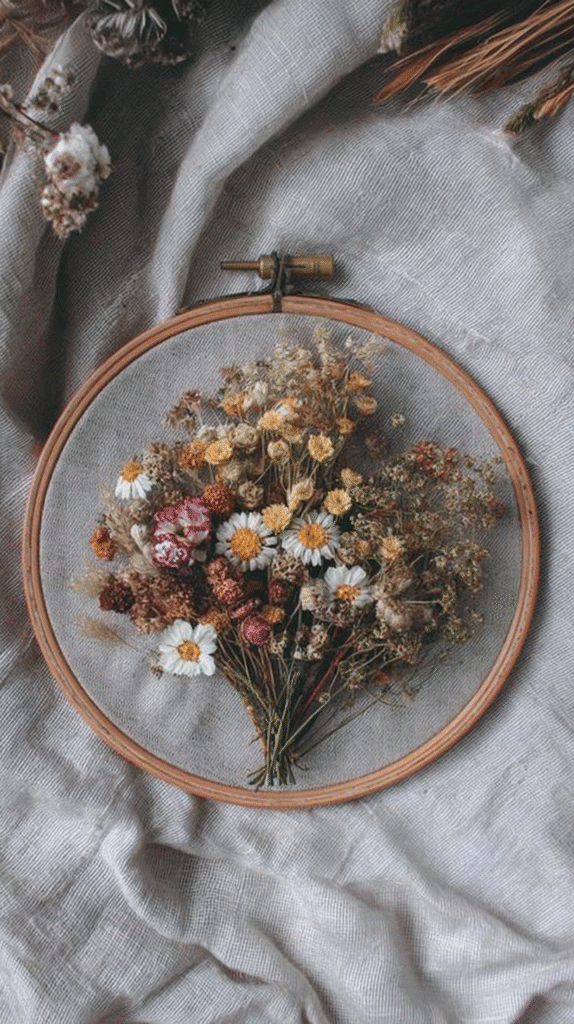
Using embroidery hoops fitted with fine mesh or netting creates a light, ethereal base for arranging dried flowers. The mesh gives delicate structure while allowing stems and petals to appear as if they’re floating within the circle.
Start by securing mesh tightly inside your hoop, trimming excess around the edge. Arrange dried blooms, grasses, or seed pods directly onto the mesh, attaching them with floral wire, thread, or a touch of clear adhesive.
Try clustering smaller flowers near the base and letting airy stems extend outward to create balance and movement.
For a softer look, leave parts of the mesh visible so light passes through and casts gentle shadows on the wall. You can display one as a focal point or group several hoops of varying sizes together for a layered, botanical wall composition.
Wall Mounted Vases or Wall Pockets

For something that changes easily, mount small wall vases or glass bud vials, woven baskets, or ceramic holders to a board or directly to the wall.
Insert dried stems as you wish.
The beauty of this option is that you can swap out floral stems seasonally or when something fades. It becomes more a rotating art installation than static art.
Resin or Glass Encased Panels

Encasing dried flowers between glass panels or in resin creates a preserved, luminous art piece. Light can pass through, revealing textures, especially if blossoms or leaves are translucent.
Things to watch: resin may yellow over time if not high quality, glass needs clean edges, pressing or flattening may be needed depending on the method.
Large-Scale Wall Installations and Foraged Murals
When you have a larger wall or want a statement, build installations: branching frameworks with hanging dried sprays, seedpods, and grasses. Imagine a meadow misted over your wall, or a season-inspired arch above a fireplace.
Support matters here: frames, wood rails, and wire grids. Weight matters too—dried materials are light, but in large quantity you’ll need solid mounting hardware.
Tips for Care, Display, and Choosing What’s Right for You
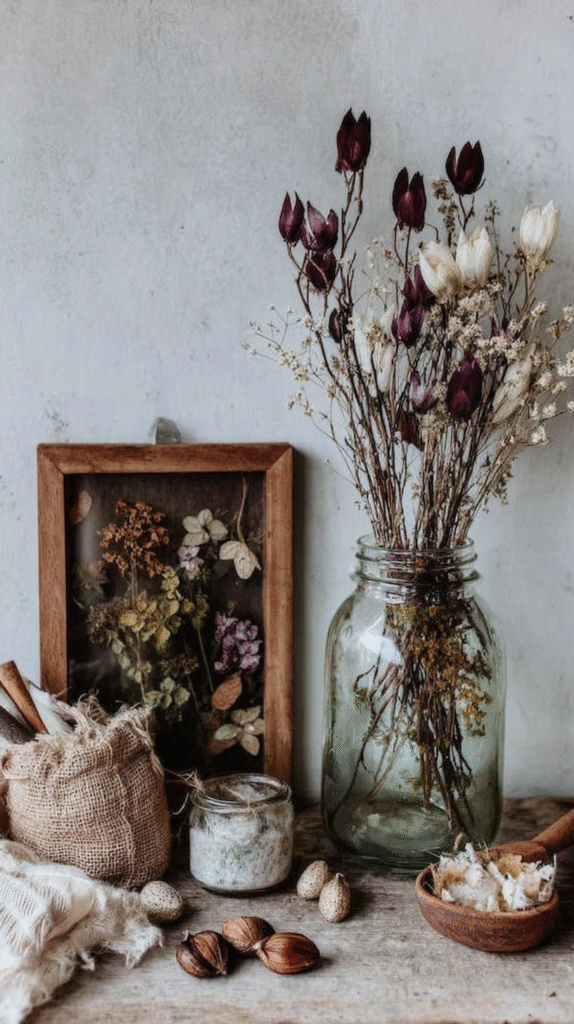
Where to hang: avoid direct sunlight (colors fade), humid or damp places (petals mould, frames warp).
Cleaning and maintenance: dust gently with a soft brush and avoid moisture. If something loosens, use a tiny dab of glue or pin to repair.
Choosing materials: match your existing palette or home mood. If you have soft neutrals, opt for muted blooms.
For bold rooms, use jewel tones or contrast. Texture counts, mix soft petals with seed pods or grasses.
Closing Thoughts
Dried flowers are humble offerings of both time and place. When we display them, we turn moments into art. No method above needs to be perfect; often the small imperfections like the broken stem, the faded color, the drift of stem against glass are what make the piece alive.
If one project calls to you, start there. Gather what you have, flowers dried in the garden or market, a frame from thrift, a wood hoop or a twig. Let your wall become a space where nature’s hush meets your own hand’s creativity.
If you try one of these, I’d love to see what you make. Share with Wild Enchantment, pin your process, and let me know which method felt most magical to you.



